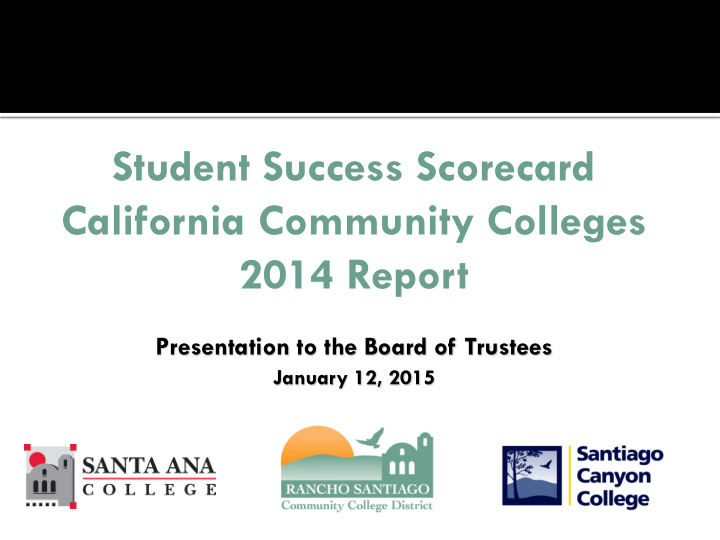



Student Success Scorecard California Community Colleges 2014 Report Presentation to the Board of Trustees January 12, 2015
In 2004, Assembly Bill 1417 triggered the creation of a performance measurement system for the California Community Colleges Legislation authorized the California Community Colleges Chancellor’s Office to design and implement a performance measurement system
Outcomes are for the system as a whole and for individual colleges Not designed to rank colleges but to provide a consistent set of data for colleges to evaluate progress over time The scorecard shows how colleges perform on metrics designed to identify achievement gaps in three primary areas of the community college mission: transfer , basic skills , and career technical education
Focus: making accountability data more readily available to the public
Description of College Student Information Annual Unduplicated Headcount Gender, Age and Ethnicity of Students Other Information ▪ FTES ▪ Course Sections (credit/non-credit) ▪ Median Credit Section Size ▪ Percentage of Full-Time Faculty (RSCCD Value) ▪ Student Counseling Ratio
Gender 41% 59% Female Male
Age 20% 22% 26% 32% < 20 years old 20 to 24 years old 25 to 39 years old 40+ years old
Ethnicity 51% Hispanic 30% White 7% Unknown Ethnicity 6% Asian 2% African-American 2% Two or More Races 1% Filipino 1% American Indian/Alaskan Native 0% Pacific Islander 0% 10% 20% 30% 40% 50% 60% 70%
Headcount 31,117 Full-Time Equivalent Students 8,251.6 Credit Sections 2,273 Non-Credit Sections 1,113 Median Credit Section Size 30 Percent of Full-Time Faculty 65.5% Student Counseling Ratio 1,004:1
Gender 43% 57% Female Male
Age 16% 29% 20% 52% < 20 years old 20 to 24 years old 25 to 39 years old 40+ years old
Ethnicity 59% Hispanic 19% White 11% Unknown Ethnicity 8% Asian 1% African-American 1% Two or More Races 1% Filipino 0% Pacific Islander 0% American Indian/Alaskan Native 0% 10% 20% 30% 40% 50% 60% 70%
Headcount 67,962 Full-Time Equivalent Students 19,933.4 Credit Sections 4,664 Non-Credit Sections 2,115 Median Credit Section Size 28 Percent of Full-Time Faculty 65.5% Student Counseling Ratio 1,352:1
Overall – Student attempted any level of Math or English in the first three years College Prepared – Student’s lowest course attempted in Math and/or English was college level Unprepared for College – Student’s lowest course attempted in Math and/or English was remedial level
Cohort (denominator) Attempted a remedial course in English, Math, or ESL for the first time Tracking level below transfer ▪ English: 1 – 4 levels below ▪ Math: 2 – 4 levels below ▪ ESL: 1 – 6 levels below Outcome (numerator) within 6 years Complete a degree applicable or transfer level course within the same discipline.
Cohort (denominator) Within 3 years complete 6 units and attempted any Math or English First Time Students Outcome (numerator) Enrolled in three consecutive semesters Summer Session and Intersession are not included
Cohort (denominator) Within 3 years complete 6 units and attempted any Math or English First Time Students Outcome (numerator) within 6 years Completion of at least 30 units
Cohort (denominator) Within 3 years complete 6 units and attempted any Math or English First Time Students Outcome (numerator) within 6 years Completion of Degree or Certificate of Achievement Transfer Transfer Prepared (60 transferable units, 2.0 GPA)
Cohort (denominator) First time in a CTE course (defined by TOP code) Completed at least 8 units in a single CTE discipline in 3 years At least one course is Advanced Occupational or Clearly Occupational Outcome (numerator) within 6 years Completed Degree or Certificate of Achievement Transfer Transfer Prepared
Remedial 100% 90% 80% 70% 66.7% 60% 50% 48.8% 40% 40.9% 30% 20% 10% 0% English Math ESL
Persistence 100% 90% 80% 77.3% 76.8% 70% 76.4% 60% 50% 40% 30% 20% 10% 0% Overall College Prepared Unprepared
30 Units 100% 90% 80% 77.6% 70% 72.7% 69.4% 60% 50% 40% 30% 20% 10% 0% Overall College Prepared Unprepared
Completion 100% 90% 80% 70% 73.3% 60% 55.7% 50% 40% 43.8% 30% 20% 10% 0% Overall College Prepared Unprepared
Career Technical Education 100% 90% 80% 70% 60% 50% 54.9% 40% 30% 20% 10% 0%
Remedial 100% 90% 80% 70% 60% 50% 40% 43.5% 38.7% 30% 20% 25.2% 10% 0% English Math ESL
Persistence 100% 90% 80% 70% 76.7% 74.1% 73.1% 60% 50% 40% 30% 20% 10% 0% Overall College Prepared Unprepared
30 Units 100% 90% 80% 70% 76.7% 68.2% 60% 64.8% 50% 40% 30% 20% 10% 0% Overall College Prepared Unprepared
Completion 100% 90% 80% 70% 67.2% 60% 50% 40% 46.0% 37.6% 30% 20% 10% 0% Overall College Prepared Unprepared
Career Technical Education 100% 90% 80% 70% 60% 50% 49.6% 40% 30% 20% 10% 0%
The Student Success Scorecard is one tool, among many, that we use to assess the effectiveness of our institutions Comprehensive and continuous assessment includes data/information from different local sources and different perspectives, such as: ▪ On-going classroom assessment ▪ On-going planning and program review (academic, student services and administrative units) ▪ On-going research carried out at district Research Department (12 Measures of Success, student satisfaction surveys, pathways to persistence, etc.)
Recommend
More recommend